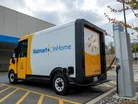Walmart's Electric Vans Target Scope 3 in Last Mile

Walmart is boldly moving toward sustainable last-mile delivery by introducing Chevrolet BrightDrop electric vans into its InHome delivery service.
The expansion enhances Walmart's reach across key US markets and highlights the company's dedication to reducing its environmental impact while boosting operational efficiency.
Expanding sustainable delivery with electric vans
Walmart's addition of 400 Chevrolet BrightDrop vans will roll out across major US cities, including Austin, Dallas, Denver, Detroit, northwest Arkansas, Orlando and the San Francisco Bay Area.
The strategic deployment of EVs supports the retailer's InHome delivery service, now accessible to 62 million households nationwide. It marks a significant step in Walmart's journey towards net-zero emissions, aiming for zero emissions across global operations by 2040.
- Category 9 | Downstream Transportation and Distribution: This is the main Scope 3 category being addressed. By using electric vans for last-mile delivery, Walmart is reducing emissions associated with the transportation of products from their distribution centres to customers' homes.
- Category 11 | Use of Sold Products: While not directly mentioned, using electric vehicles for delivery could indirectly influence this category by potentially reducing emissions associated with customers driving to stores to pick up products.
- Category 12 | End-of-Life Treatment of Sold Products: Although not explicitly stated, improved delivery efficiency could potentially impact this category by optimising the collection and disposal of products at the end of their lifecycle.
It's important to note that Scope 3 emissions typically account for the vast majority of a retailer's carbon footprint. For many retailers, especially in the home and fashion segments, Scope 3 emissions can constitute up to 98% of their total carbon footprint.
Walmart's initiative to incorporate electric vans into its delivery fleet is a broader strategy to reduce its environmental impact across its value chain.
It aligns with the company's goal to achieve zero emissions across its global operations by 2040, which includes its fleet of approximately 10,000 tractors and 80,000 trailers.
Advanced features for enhanced efficiency and safety
Chevrolet's BrightDrop 400 vans have advanced features tailored to enhance safety, efficiency and driver comfort.
Warren Moore, vice president of Dedicated Delivery at Walmart US, states: "With a focus on being people-led and tech-powered, we're always looking for ways to enhance the associate experience and provide the best-possible service to our customers. That's why we're excited about adding the BrightDrop 400 to our InHome delivery fleet."
The initiative provides customers with greater convenience and delivers on Walmart's commitment to sustainability through cutting-edge technology and eco-friendly practices.
Addressing Scope 3 emissions through electric innovation
- 360-degree HD Surround Vision Camera and Blind-Zone Steering Assist: These features enhance driver awareness, particularly in high-traffic and residential areas, helping associates navigate more safely.
- Automation Features like Auto-Closing Doors: These features improve efficiency, ensuring drivers can perform multiple deliveries swiftly without compromising safety.
- Low-Step Ergonomic Design: With easier ingress and egress, drivers can make frequent stops quickly, expediting the last-mile delivery and reducing physical strain.
The features were positively reviewed during a pilot programme with GM, where Walmart's InHome associates tested the BrightDrop vans in real-world scenarios.
They noted the vans' manoeuvrability in urban and densely populated areas and found the automation features highly beneficial.
The components directly support Walmart's operational goals by making last-mile delivery more efficient and worker-friendly.
Leading the way in green retail logistics
By integrating BrightDrop electric vans into its fleet, Walmart is setting a benchmark for sustainable practices in the retail sector.
Sandor Piszar, vice president of GM Envolve, notes: "Our BrightDrop vans are purpose-built to get the job done safely and efficiently while helping businesses like Walmart decarbonise their fleet."
The pilot programme highlights BrightDrop's potential to enhance delivery logistics while reducing environmental impact.
A greener future for retail delivery
Walmart's strategic adoption of Chevrolet BrightDrop electric vans is a testament to the company's commitment to sustainability and innovation.
By prioritising last-mile delivery, Walmart tackles one of the most emission-intensive segments of the supply chain, positioning itself as a trailblazer in the green retail logistics movement.
Through this forward-thinking initiative, Walmart continues to improve the customer experience, reduce its environmental impact and support its associates—all while setting a standard for sustainable practices in the industry.
Receive the next edition of Scope 3 Magazine by signing up for its newsletter.
As part of this portfolio, make sure you check out Procurement Magazine and also sign up to our global conference series - Procurement & Supply Chain LIVE.
Scope 3 Magazine is a BizClik brand.
- Global Scope 3 Emissions: A Corporate Sustainability ShiftScope 1 2 and 3
- IKEA Preowned Launches to Tackle Scope 3 EmissionsCircular Economy
- Ascend Elements' Lithium Recovery Tackles Scope 3 EmissionsCircular Economy
- Boeing & CSIRO's Collaboration to Tackle Scope 3 EmissionsScope 1 2 and 3
Featured Articles
Estonia, Latvia and Lithuania join the European grid, cutting ties with Russian energy, a move that boosts regional security and sustainability
TÜV SÜD: New battery regulations bring Scope 3 hurdles, requiring sustainable sourcing, digital traceability and design changes increasing compliance
Nissan is scaling up its use of green steel, reducing CO2 emissions in its supply chain as part of its goal to achieve carbon neutrality by 2050
